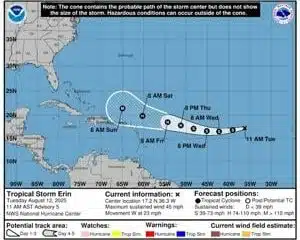(The Center Square) – Saying eradication of dangerous gangs such as Tren de Aragua goes well beyond individual arrests, a North Carolina congressman’s proposal would create a six-month plan identifying tactical methods, funding and origins.
The strategy, leadership and presence of criminal threats by the multi-country gang would be uncovered and shared by the Department of Homeland Security and relevant federal agencies, says the bill filed by U.S. Rep. Brad Knott, R-N.C. The Tren de Aragua Border Security Threat Assessment Act, known also as House Resolution 4070, has moved through the Border Security and Enforcement Committee and next is up for a voice vote.
“We are for legal immigrants who will help this country,” said Knott, a former federal prosecutor. “Every other category needs to be removed and precluded from coming here in the first place and that’s what we’re working toward.”
The proposal, as of Friday morning, was yet to attract a Democrat in the cosponsor list. Republicans there number 23.
“This bill that we got out of committee, going back to the Colorado incident, arresting the individual who has an AR-15 or an AK-47 on the sidewalk – that needs to happen,” Knott said. “But that’s not where it stops. And this commissions the Department of Homeland Security to really address the root cause, to go beyond the flower, beneath the surface, to the root. And if you kill the root, the whole plant dies.
“This is going to leverage a study to say how they are operating so effectively in our country. Once we figure out how they’re operating, we’re going to have a tactical plan for all 50 states, every law enforcement officer in the country will be a part of this. Arresting the drug dealer, arresting the guy that’s walking around with the pistol or a rifle, that needs to happen. But it’s wholly insufficient. It is going to the root that is going to solve this problem.”
Knott, in a published interview, not only believes TdA is operating in his home state but throughout the country. He varied on exacts, at one time saying in 16 to 20 states, another saying 20 to 25, and saying, “We’d be naïve not to believe they’re in 45 to 50 states.”
“In North Carolina, absolutely, there’s been a very real increase in arrests where it’s been confirmed that criminals with drugs, firearms, human trafficking and so forth, are tied to TdA,” Knott said. “In regard to my confidence level that they are in 50 states, I am confident they are in 50 states or a significant portion of states. Again, these people have marched from Venezuela all the way up the western hemisphere into the United States and into Canada. They have become very proficient at blending in, utilizing benign channels and then poisoning their communities with carnage, death, drugs and destruction.”
Knott says Tren de Argua operates not only in Venezuela but has expanded into Chile, Bolivia, Brazil, Peru and Mexico.
Knott said the gang is here through multiple years of access and proximity. He believes they are “underneath the surface” actively strengthening their presence.
“I saw that in my career in law enforcement,” he said. “The best criminals are the ones you don’t see until it’s too late.”
Knott’s proposal comes in a week where speculation on infiltration by immigrants from the Middle East has ramped up. Reports vary, and Knott does not discount any of the chatter.
“Given the scale of it, we have got to move forward together in lock step to address them as holistically as we can,” Knott said. “And yes, sleeper cells from the Middle East, that’s a big problem. Again, if you want to wait until we know that they’re here to commit us harm? I don’t think so. We need to get ahead of it.”
Like other Republicans, he squared blame on the last four years during the administration of President Joe Biden. Under his watch, Knott estimates the true total of illegal immigrants at 20 million and says former Vice President Kamala Harris shares in that blame.
“This problem, it’s a mortal wound to the country if we don’t fix it,” Knott said. “When you had a border policy like Biden and Harris, adversaries from around the world utilized it. They exploited it. It wasn’t passive. It was an active solicitation, where we went around the world to bring people into this country illegally.
“Of course, Iran exploited that policy. Or course China exploited that policy. But so did an immediate threat like TdA.”


















































